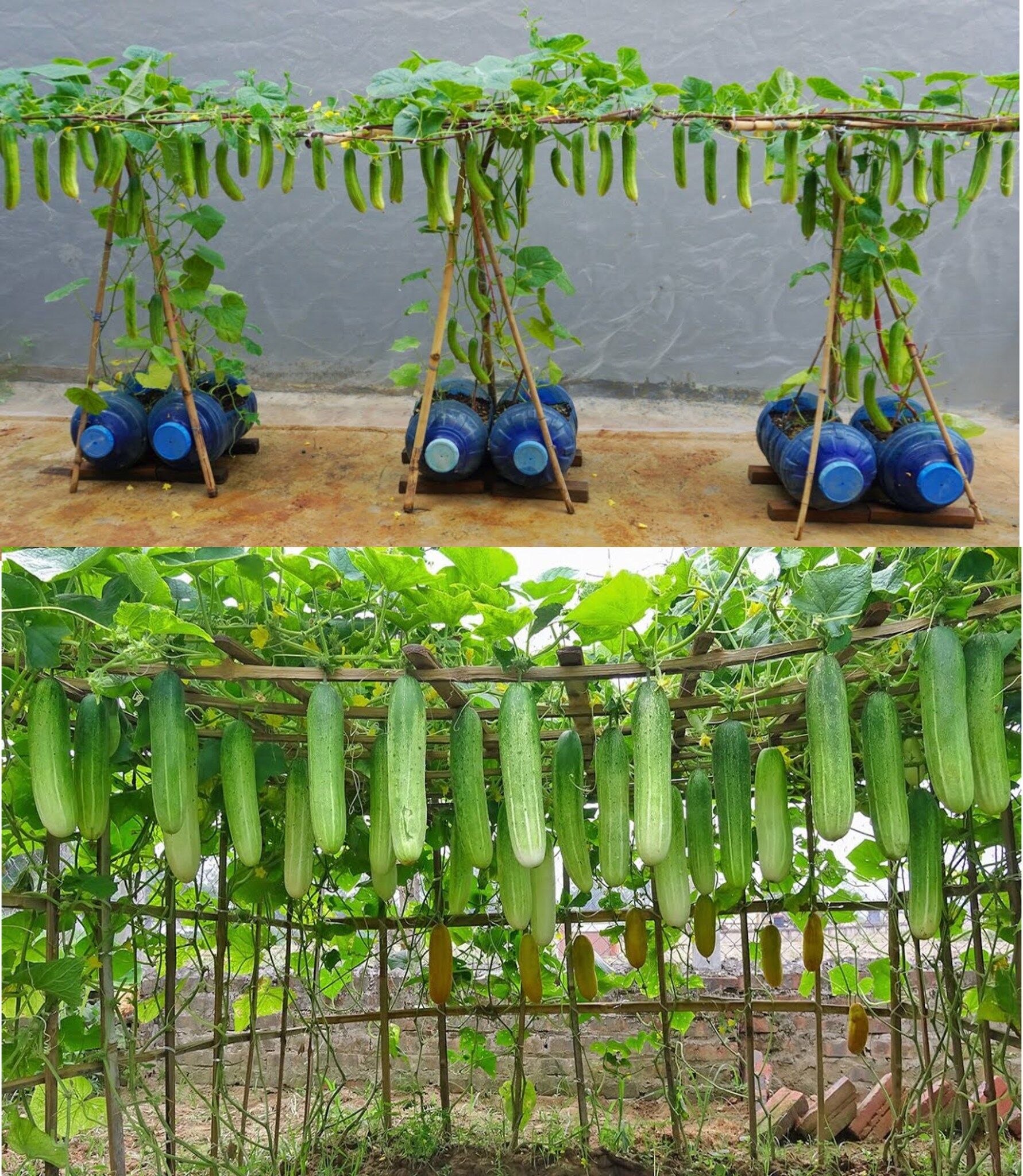Growing cucumbers vertically with a trellis is a game-changer! It saves space, keeps the fruits clean, and helps maximize your garden’s potential. If you’re looking for creative ways to build your own cucumber trellis, here are 9 DIY ideas you can try to make harvesting easy and efficient:
1. A-Frame Trellis
Materials:
Wooden stakes or PVC pipes
Horizontal bar (wooden or PVC)
Netting or wire mesh
Screws or zip ties
Steps:
Create two A-shaped frames by attaching wooden stakes or PVC pipes at the base, leaning them inward.
Connect the top of the frames with a horizontal bar for extra stability.
Attach netting or mesh between the two frames using screws or zip ties.
Plant cucumbers at the base and train the vines to grow up the mesh.
Benefits: The A-frame design provides sturdy support and encourages vertical growth, making harvesting easier.
2. Cattle Panel Trellis
Materials:
Cattle panel
Metal stakes
Zip ties or wire
Steps:
Bend the cattle panel into a gentle arch.
Secure it with metal stakes at both ends to keep it upright.
Optionally, you can fasten the panel with zip ties or wire for extra strength.
Benefits: This design allows cucumbers to grow easily along the arch, giving you a beautiful structure and maximizing space.
3. Teepee Trellis
Materials:
Bamboo or wooden poles
Twine or garden wire
Steps:
Arrange bamboo or wooden poles in a teepee shape, with the tops meeting at a point.
Secure the poles together at the top using twine or garden wire.
Wrap twine around the poles from top to bottom to create a framework for the vines to climb.
Benefits: This tepee style offers a natural aesthetic while giving your cucumbers plenty of space to grow upward.
4. Ladder Trellis
Materials:
Old wooden ladder
Stakes (optional)
Steps:
Lean an old wooden ladder against a fence or wall.
Secure the ladder with stakes if needed to prevent it from tipping over.
Train cucumber vines to climb the rungs of the ladder as they grow.
Benefits: Reusing an old ladder is a sustainable and creative way to build a functional cucumber trellis.
5. String Trellis
Materials:
Two sturdy posts
Twine or garden string
Steps:
Install two vertical posts in the ground about 6-8 feet apart.
Run twine or garden string between the posts, spacing the strings about 4-6 inches apart.
Secure the string at the top and bottom with knots, ensuring the cucumber vines can climb.
Benefits: This simple and inexpensive trellis system works well for small spaces and is easy to build.
6. Fence Trellis
Materials:
Existing chain-link fence or wooden lattice
Steps:
Plant cucumbers at the base of an existing chain-link fence or wooden lattice.
Train the cucumber vines to grow along the fence by gently guiding them upwards.
Benefits: If you already have a fence in place, this is a convenient option that doesn’t require much additional construction.
7. Arched Trellis
Materials:
Wire mesh or cattle panels
Stakes
Zip ties or wire
Steps:
Bend wire mesh or cattle panels into an arch.
Secure the arches with stakes on either side.
Optionally, use zip ties or wire to fasten the panels in place.
Benefits: The arched shape offers ample growing space and creates a beautiful, garden-friendly trellis.
8. Wall-Mounted Trellis
Materials:
Wooden slats or metal grid
Screws or brackets
Steps:
Mount a grid or slatted trellis to a garden wall using screws or brackets.
Train cucumber vines to grow upward by guiding them along the slats or mesh.
Benefits: A wall-mounted trellis saves space and works well for small gardens or balcony setups.
9. Obelisk Trellis
Materials:
Wooden slats or metal rods
Screws or zip ties
Steps:
Construct a pyramid-shaped structure by arranging slats or rods in a triangular formation.
Secure the pieces at the top with screws or zip ties.
Add cross pieces for additional support, then train cucumber vines to climb up the obelisk.
Benefits: This trellis design adds height and elegance to your garden while offering plenty of vertical space for cucumbers to grow.
Tips for Successful Cucumber Trellising 🌱
Plant Spacing: Space cucumber plants about 12-18 inches apart to give them enough room to grow and climb the trellis.
Training Vines: As cucumbers begin to grow, gently guide the vines onto the trellis. This encourages vertical growth and helps the plant stay upright.
Watering: Cucumbers require consistent moisture, so water regularly to keep the soil moist but not waterlogged.
Fertilization: Use a balanced fertilizer according to package instructions to ensure your cucumbers receive adequate nutrients for healthy growth.
By choosing one of these 9 DIY cucumber trellis ideas, you’ll not only save space in your garden but also ensure that your cucumbers grow in an organized, manageable way. Happy gardening! 🌿🍅
More Articles You Might Like
-
Texas Toast Sloppy Joes: The Crunchy, Cheesy Upgrade You Didn’t Know You Needed
There’s something timeless about sloppy joes. For generations, this saucy, savory, and slightly sweet ground beef sandwich has been a go-to comfort food in American kitchens. It’s quick, filling, and family-friendly—perfect for busy weeknights. But what if we told you there’s a way to take this classic dish up a notch? Enter the Texas Toast…
-
Classic Pig Pickin’ Cake
When it comes to Southern desserts, few sweets shine as brightly as the Classic Pig Pickin’ Cake. This nostalgic cake, sometimes called a “Mandarin Orange Cake,” has roots deep in Southern tradition. It gets its playful name from its frequent appearance at pig pickin’s—Southern-style barbecue gatherings where communities come together to enjoy slow-cooked pork, sides,…
-
Lemon Garlic Butter Chicken with Creamy Parmesan Pasta
There’s something irresistible about the combination of tender, golden-browned chicken paired with a creamy pasta coated in Parmesan cheese. Add the brightness of lemon, the depth of garlic, and the richness of butter, and you have a recipe that feels indulgent yet approachable enough for a weeknight dinner. Lemon Garlic Butter Chicken with Creamy Parmesan…



